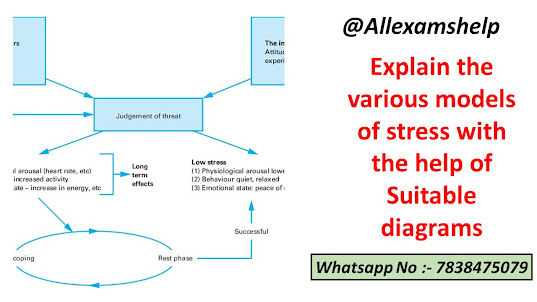There are several models of stress that attempt to explain how stress affects individuals. Three of the most well-known models are the General Adaptation Syndrome (GAS) Model, the Transactional Model of Stress and Coping, and the Biopsychosocial Model of Stress.
General
Adaptation Syndrome (GAS) Model: The GAS model was proposed by Hans Selye in
1936, and it describes the physiological changes that occur in response to
stress. The model consists of three stages: alarm, resistance, and exhaustion.
Explain the various
models of stress with the help of suitable diagrams
Alarm stage:
When a person encounters a stressor, the body's sympathetic nervous system is
activated, leading to the release of stress hormones such as cortisol and
adrenaline. This causes physiological changes such as increased heart rate,
blood pressure, and respiration rate.
Resistance
stage: If the stressor persists, the body enters the resistance stage, where it
attempts to adapt to the stressor by releasing more stress hormones and
utilizing energy reserves. This stage can last for a prolonged period of time.
Exhaustion
stage: If the stressor persists for an extended period, the body's resources
become depleted, and the body enters the exhaustion stage. In this stage, the
individual may experience physical and emotional exhaustion, and may be more
susceptible to illness.
Transactional
Model of Stress and Coping: The Transactional Model of Stress and Coping was
proposed by Richard Lazarus and Susan Folkman in 1984. This model emphasizes
the role of cognitive appraisal in the stress response. According to this
model, stress is a result of an individual's evaluation of a situation and
their ability to cope with it.
Primary
appraisal: The individual evaluates the situation to determine whether it is a
threat or a challenge.
Secondary
appraisal: The individual evaluates their ability to cope with the situation.
Biopsychosocial
Model of Stress: The Biopsychosocial Model of Stress was proposed by George
Engel in 1977. This model emphasizes the interplay between biological,
psychological, and social factors in the stress response.
Biological
factors: This includes genetics, physiological responses, and the impact of
stress on the body.
Psychological
factors: This includes cognitive appraisal, coping strategies, and personality
factors.
Social factors:
This includes the impact of social support, cultural factors, and environmental
stressors.
There are
several models of stress, each providing a different perspective on how stress
affects individuals. Here are some of the most commonly cited models:
The
transactional model of stress: This model proposes that stress is a dynamic
process that involves an interaction between an individual and their
environment. According to this model, stress arises when an individual
perceives a situation as threatening, challenging, or overwhelming. The
individual then evaluates their ability to cope with the situation and decides
on an appropriate course of action.
The general
adaptation syndrome (GAS) model: This model suggests that stress follows a
predictable pattern of physiological responses. According to this model, the
body responds to stress with three stages: the alarm stage, the resistance
stage, and the exhaustion stage.
The
diathesis-stress model: This model proposes that stress arises from an
interaction between an individual's predisposition (diathesis) and
environmental stressors. According to this model, individuals who are
predisposed to certain conditions (such as depression or anxiety) are more
likely to experience symptoms of these conditions when exposed to stress.
The cognitive
appraisal model: This model suggests that stress arises from an individual's
appraisal of a situation. According to this model, stress is not caused by
external events themselves, but by the individual's interpretation of those
events. The model proposes that stress arises when an individual perceives a
situation as threatening or challenging, and believes that they do not have the
resources to cope with it.
For SOLVED PDF & Handwritten
WhatsApp No :- 7838475019
The social
support model: This model suggests that social support can buffer the effects
of stress. According to this model, individuals who have strong social support
networks are better able to cope with stress than those who do not.
Overall, these
models provide different ways of understanding stress and its effects on individuals.
Understanding these models can help individuals to identify sources of stress,
and develop effective coping strategies.
